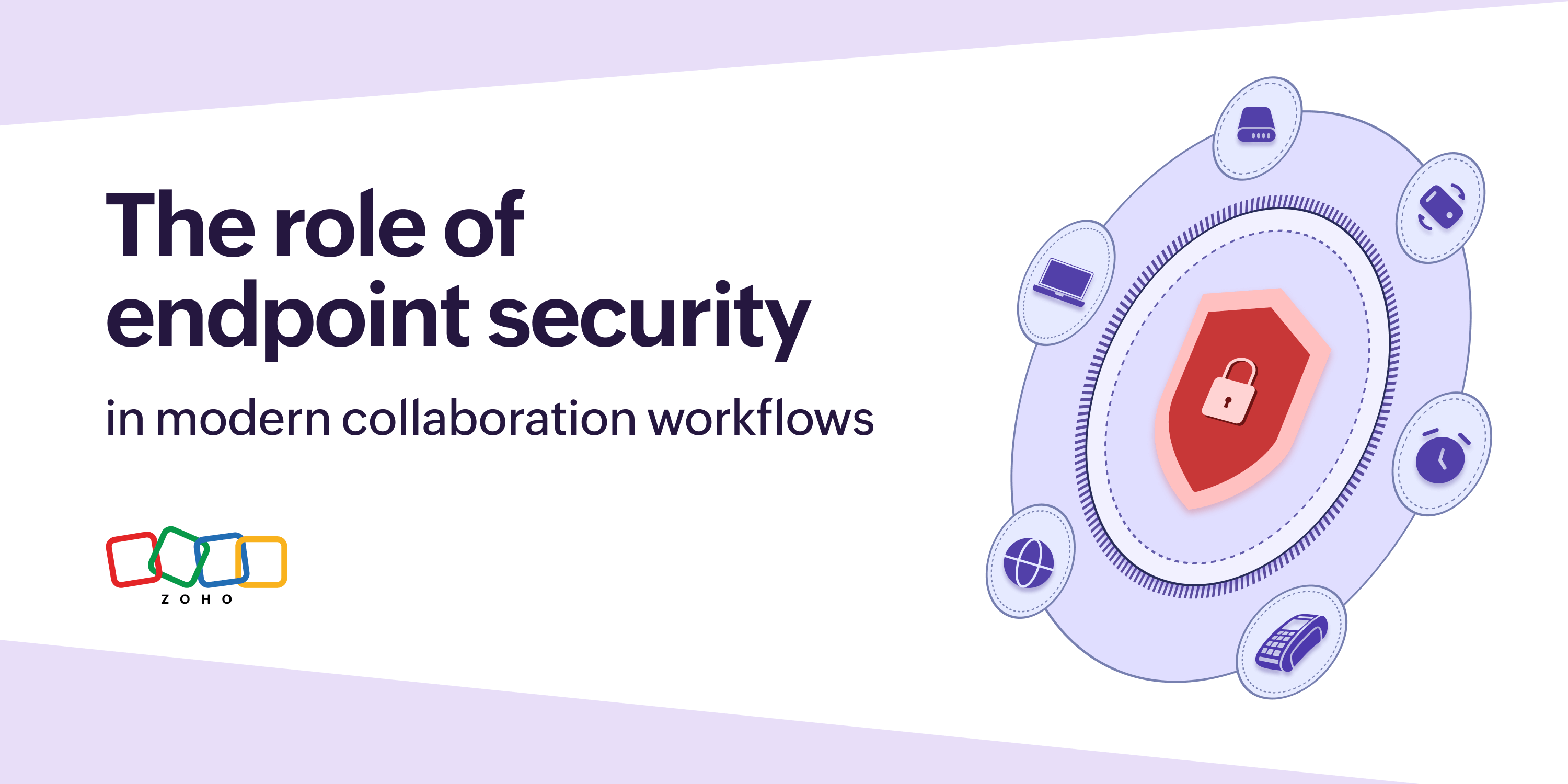- HOME
- All Products
- Collaboration
- Organizational announcements: What are they and why they matter (more than you think)
Organizational announcements: What are they and why they matter (more than you think)
- Published : November 25, 2025
- Last Updated : November 27, 2025
- 206 Views
- 8 Min Read
Every organization has that moment.
A new policy drops.
A department is reshuffled.
Someone new joins, someone moves teams, or something big is quietly brewing in the background.
And suddenly, the workspace feed starts buzzing.
"Did you hear?”
“Is this confirmed?”
“Why are we changing this now?”
Before anyone has the full picture, conversations multiply. People form theories. Someone screenshots half a conversation and forwards it with the caption “What’s happening?” Productivity takes a backseat as curiosity and uncertainty take the wheel. Human nature fills the silence with assumptions, and assumptions are rarely kind or accurate. This is the moment where communication becomes a leadership act.
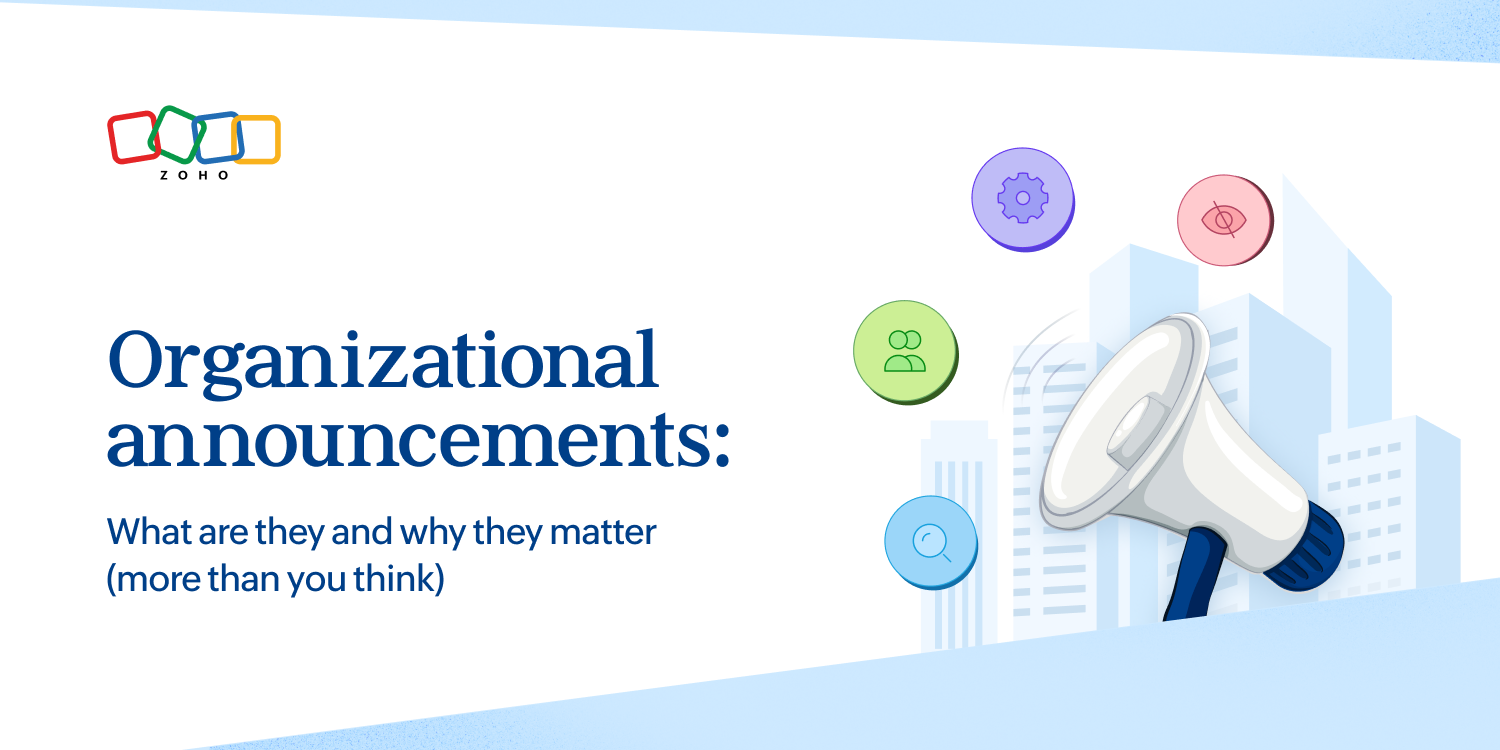
A clear, timely message can quiet the noise instantly. It can interrupt speculation with facts, replace confusion with context, and shift the energy of the entire organization from reacting to understanding. One thoughtful announcement can turn anxious whispers into alignment—the kind where people feel included, informed, and prepared for what comes next.
Because at its core, an organizational announcement isn’t about sharing information. It’s about honoring people with clarity. It says: “You deserve to know what’s happening and why. You’re not on the outside of this. You’re part of it.” That single moment of transparency can determine whether a change becomes chaotic or seamless, resisted or embraced. In a fast-moving workplace, clarity isn’t just communication—it’s stability.
What is an organizational announcement?
An organizational announcement is more than just an update. It’s the company’s way of making sure everyone is on the same page when something meaningful happens. Ideally an intentional communication, it explains what’s changing, why it matters, and how it affects the people within the organization.
At first glance, it may seem like a simple message. But in reality, an announcement carries the weight of leadership. It’s a small moment that reflects how a company treats its people—whether they're transparent, trustworthy, and respect their employees’ need to understand what’s going on.
In growing or hybrid workplaces, announcements have taken on even more importance. Teams aren’t always in the same room, and information doesn’t flow naturally across desks anymore. The announcement, then, becomes the thread that keeps everyone connected. It ensures that change, no matter how complex, feels shared and not sprung upon.
Think of it as a bridge between decision and understanding. When leaders decide something important like launching a new policy, changing reporting lines, or introducing a fresh direction, employees shouldn’t be left to interpret it from whispers around the water cooler or half-true information. The announcement steps in as the official voice of the organization. It makes sure no one has to guess, and everyone has the same version of the truth.
Types of organizational announcements
Not every announcement is created equal. Some are meant to inform, some to inspire, and some to soften the blow of inevitable change. Depending on the kind of message you're delivering, you set the tone, timing, and even the medium. Recognizing the type of announcement you’re making helps you strike the right balance between transparency and tact, and ensures that your message actually lands the way you intend it to.
Broadly speaking, organizational announcements fall into a few key categories. Each serves a distinct purpose, but together, they form the rhythm of how an organization communicates.
1. General announcements
These are the simple, everyday updates that keep the whole place ticking. They don’t change the company’s direction, but they do keep everyone moving in the same one.
For instance, it could be about a new internal tool is being rolled out, or an office holiday has been declared, or about a small tweak in company policy. Nothing fancy. Just the usual stuff.
Nobody throws confetti for these, but they matter. Because if you don’t tell people, you’ll definitely hear these from them later—“Wait, when did that change?” “Why didn’t anyone mention this?”. That’s when confusion starts doing laps around the office.
So these updates deserve their moment—short, clear, and right on time. No fluff, no drama, just keeping the lights on and everyone in the loop.
2. People and culture announcements
These are the heart warmers. The small celebrations, the big wins, the human moments that make a workplace feel a little less like work.
Someone just joined the team. Someone else got promoted. A long-time colleague is celebrating five years at the company. You don’t just announce these things—you share them. Because they remind everyone that this place isn’t just powered by policies and projects, but by people.
People and culture announcements are how an organization says, “We see you.” They make new employees feel welcomed, seasoned ones feel valued, and everyone in between feel like they belong to something that notices and appreciates effort.
It’s not about making a grand speech every time someone has a birthday or work anniversary. It’s about pausing long enough to acknowledge the humans behind the work. A quick post, a cheerful email, or a heartfelt shout-out in the all-hands—that’s all it takes. Because in the long run, these small celebrations do more for culture than any corporate event ever could.
3. Strategic and leadership announcements
This is where things get interesting. These aren’t your everyday “FYI” updates—they’re the big ones. The kind that makes people stop mid-scroll, raise an eyebrow, and go, “Oh, this is serious.”
A merger. A new CEO. A bold vision for what’s next.
Strategic announcements are how leadership steers the ship and lets everyone know which way the wind’s blowing. But there's a tricky part to it. These messages aren’t just about what’s changing. They’re also about how people feel about that change. Because let’s be honest, the moment a big announcement drops, curiosity and concern arrive as a pair.
So the tone matters a lot. It needs to be confident, but not corporate; transparent, but not terrifying. Employees look to leadership for reassurance that the future isn’t just different, it’s deliberate.
When done right, these announcements don’t just share direction; they create belief. They make people feel part of the journey, not just passengers on it. And that’s how you turn uncertainty into alignment, and a memo into momentum.
4. Operational announcements
These are the nuts-and-bolts updates that keep the machine running smoothly. Not the most glamorous part of internal communication, but easily one of the most important.
They could be a new process for logging expenses, a system update scheduled for midnight, or a compliance form that needs to be filled before Friday. They may sound routine, but when these things aren’t communicated properly, chaos loves to sneak in.
Operational announcements are the “here’s what’s changing and here’s what you need to do” kind of updates. They’re about clarity, not charm. People should be able to glance through and instantly know what’s required of them without any decoding and follow-up questions. Because when operations run smoothly, nobody notices—and that’s exactly the point.
5. Crisis or sensitive announcements
Every organization, no matter how well run it is, hits a rough patch once in a while. Maybe a key leader decides to move on. Maybe a market shift forces some tough calls. Or maybe something unexpected happens that demands transparency at the earliest.
These are the moments when communication stops being just another task and becomes a test of trust.
Crisis or sensitive announcements aren’t about spin; they’re about steadiness. People always don’t expect perfect news. In fact, they expect honesty. They want to know what happened, how it affects them, and what’s being done about it.
The right tone here is calm, sincere, and accountable. Don’t sugar-coat, don’t panic, and definitely don’t go silent. Even a short, factual update is better than leaving people to fill in the blanks themselves because in the absence of clarity, rumor usually takes the mic.
A well-written crisis announcement doesn’t just share news; it restores confidence. It tells people, “Yes, this is hard. But we’re handling it—and we’ll get through it together.”
Organization announcements templates
Every announcement can have its own personality, but the best ones follow a simple rule: Be clear, be human, and don’t make people guess what you’re trying to say.
To make life easier, here are a few templates you can adapt—whether you’re sharing a small update, a big change, or a moment worth celebrating. Think of these as starting points, not scripts. Tweak them, shorten them, dress them up, or strip them down depending on your company’s style and the seriousness of the moment.
1. General announcement template
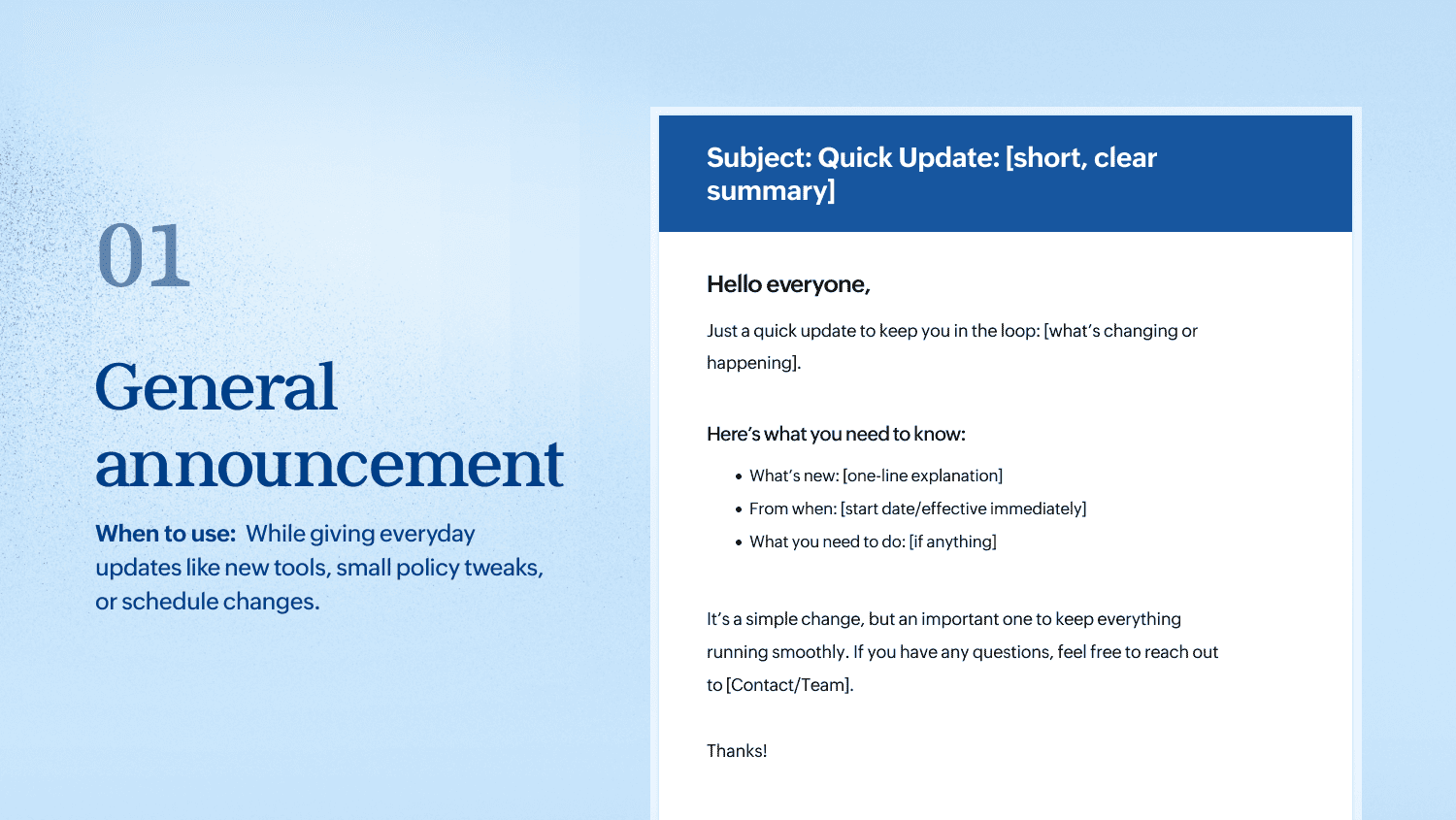
2. People and culture announcements template
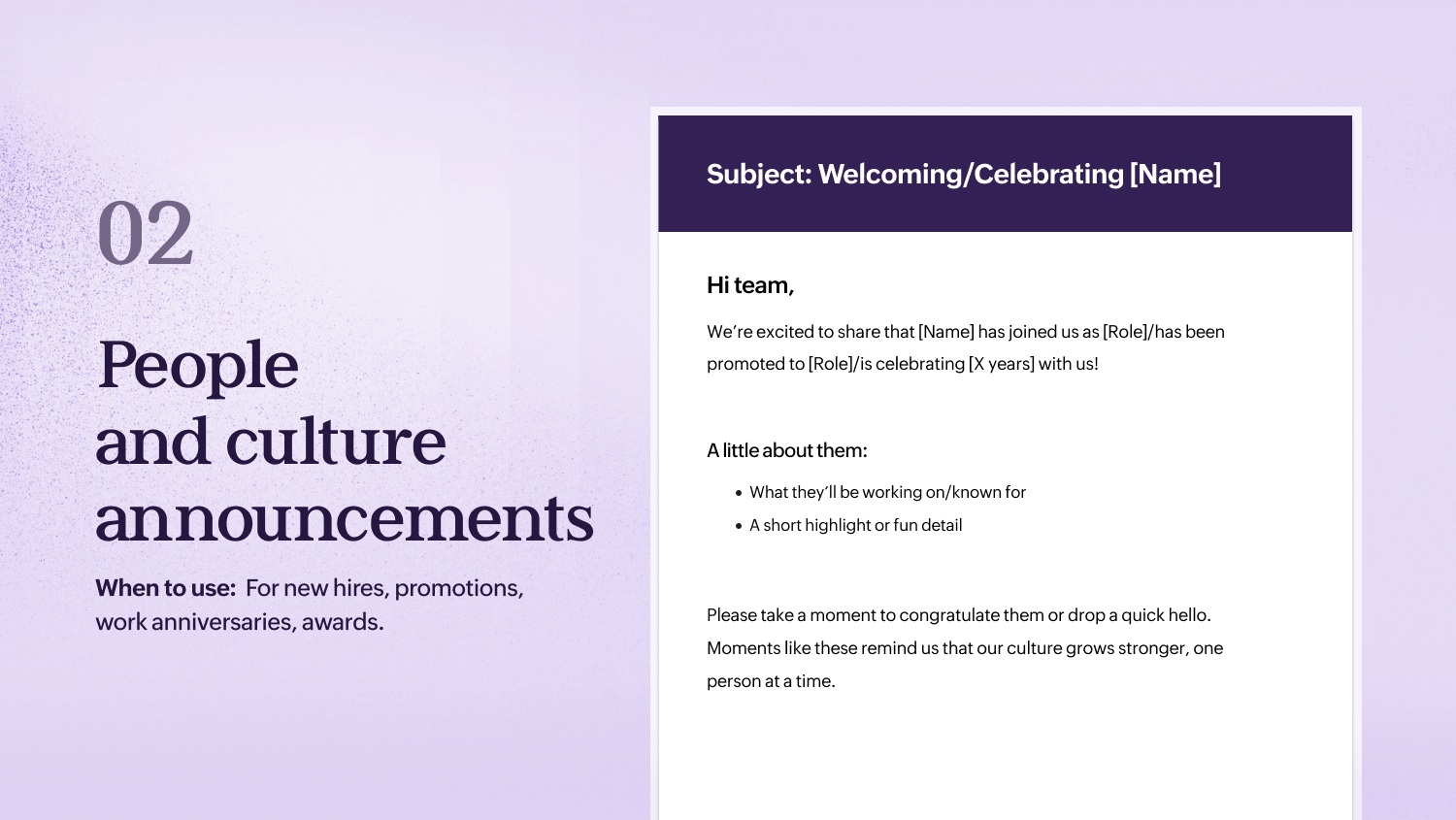
3. Strategic or leadership announcement template

4. Operational announcement template
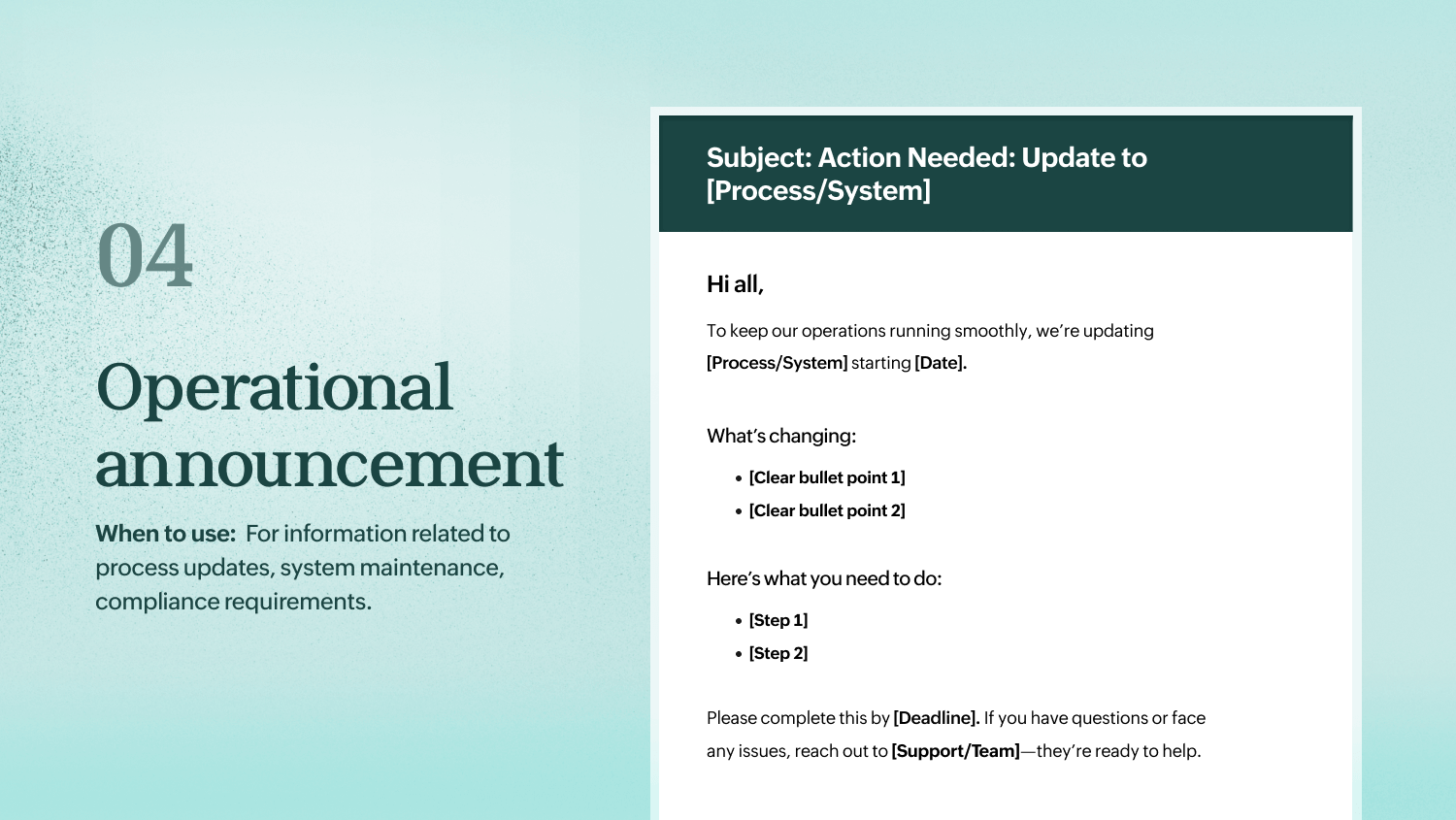
5. Crisis or sensitive announcement template

How to write an organizational announcement: A step-by-step guide
1. Define the message and its purpose.
Before typing a single line, get absolute clarity on three things:
- What exactly is the update?
- Why does it matter right now?
- What should employees do after reading it (if anything)?
This step helps you filter noise, avoid vague statements, and decide whether the announcement should inform, guide action, or shape sentiment. A clear purpose makes the writing sharper and the communication stronger.
2. Draft with structure, clarity, and the right tone.
Begin with a straightforward opening: state the update upfront. Follow it with a short explanation of why the change is happening or what prompted it. But remember to keep it relevant.
Then add the practical details:
- What’s changing?
- When does it takes effect?
- Who does it impact?
- What support/resources are available?
Tone matters, too. A process update needs precision. A leadership update needs reassurance. A policy update needs authority. Match the tone to the nature of the announcement so it lands correctly.
3. Route it through the right approval workflow.
Announcements often represent decisions made by someone else. It can be the HR, Finance, IT, Admin, or Leadership. So once your draft is ready, move it through your internal approval chain:
- Draft owner review (the team responsible for the update).
- Stakeholder check (e.g., HR confirms compliance, IT confirms timelines).
- Leadership or department head sign-off (when required).
This ensures that the details are accurate, the messaging is consistent, and no department is caught off guard after the announcement goes live.
4. Target the right audience and schedule smartly.
A good announcement reaches exactly the people who need it, not the entire company by default.
Use segmentation options to target:
- Specific departments or teams.
- Office locations or regions.
- Job roles and levels.
- New employees.
Once the audience is set, pick the right timing. Schedule the announcement when employees are most likely to read it, avoiding off-hours, weekends, or peak workload times. If the update is time-sensitive, use alerts or pinned posts.
5. Publish, monitor engagement, and follow up.
After posting, your work isn’t over. Check who’s seen the announcement, who hasn’t, and whether follow-up communication is needed.
Depending on the update, this may mean:
- Sending a quick reminder.
- Sharing a short FAQ.
- Providing a help document or training video.
- Requesting acknowledgements for compliance-related updates.
Use engagement insights to refine how you craft and time future announcements. Over time, this helps employees trust and rely on internal messages instead of skimming or skipping them.
Wrapping up
At the end of the day, organizational announcements are just a part of how people talk to each other at work. Some are big, some are tiny, and most of them land somewhere in the middle. But they all serve one purpose: helping people understand what’s going on so they can do their jobs without second-guessing everything.
When an announcement is clear, people feel less lost. When it arrives on time, there’s less scrambling. And when it explains the “why” instead of just the “what,” it makes a huge difference in how people respond to change.
There’s nothing fancy about it. It’s simply about being open, being timely, and not leaving people to fill in the blanks on their own. If your announcements can do that consistently, they’ll quietly become one of those things nobody notices when done well, but everyone notices when they’re done badly. And honestly, that’s the sweet spot.
 Anjana Balaji
Anjana BalajiAnjana is a passionate marketer who works for Zoho. Apart from the crazy movie buff that she is, she's also a trained musician and a creative home-chef!
